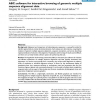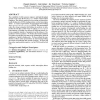85 search results - page 7 / 17 » Identifying DNA and protein patterns with statistically sign... |
BMCBI
2004
13 years 7 months ago
2004
Background: Alignment and comparison of related genome sequences is a powerful method to identify regions likely to contain functional elements. Such analyses are data intensive, ...
BMCBI
2006
13 years 7 months ago
2006
Background: Several entropy-based methods have been developed for scoring sequence conservation in protein multiple sequence alignments. High scoring amino acid positions may corr...
RECOMB
2003
Springer
14 years 8 months ago
2003
Springer
The availability of whole genome sequences and high-throughput genomic assays opens the door for in silico analysis of transcription regulation. This includes methods for discover...
RECOMB
2004
Springer
14 years 8 months ago
2004
Springer
The challenge of similarity search in massive DNA sequence databases has inspired major changes in BLAST-style alignment tools, which accelerate search by inspecting only pairs of...
BMCBI
2010
13 years 7 months ago
2010
Background: The classification of protein sequences using string algorithms provides valuable insights for protein function prediction. Several methods, based on a variety of diff...


